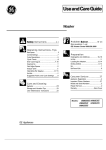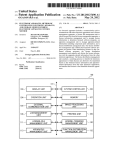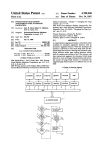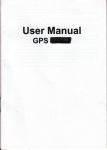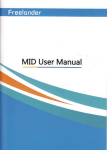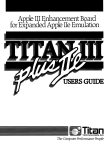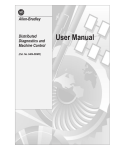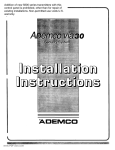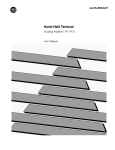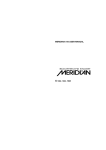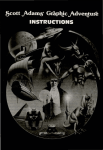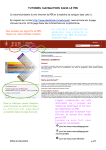Download Method for selectively returning to the beginning or the previous
Transcript
United States Patent [191 [1 1] [45] Croes et a1. 1541 Chang et a1, “OCR/Visual Editing System”, IBM TDB Gentry; Milton L. Gentry, Jr., both of Leander; Melvin R. Kendrick, Round [221 [51] [521 [58] Filed: vol. 21, N0. 2. Jul. 1978, pp. 718-719. Lotus 1-2-3 User's Manual, Lotus Development Corpo ration, 1983, pp. 169-180. Office System 6 Visual Instruction Program, IBM Infor mation Processors Reference Book. IBM Corporation, 1979, pp. 5-94-5-95. International Technology Disclosures 88403 (Anonymous Publication), “Automated Thesaurus For Temporary Rock, all of Tex. International Business Machines Corporation, Armonk, N.Y. Appl. No.: 873,756 [21] [56] Jun. 13, 1986 Replacement of Synonyms”, (Aug. 25, 1984). Int. Cl.‘ ....................... .. G06F 3/14; G06F 15/00 U.S. C1. . Field of Search 364/900; 400/63 Primary Examiner-Raulfe B. Zache 364/200 MS File, 900 MS File, 364/518; 400/63, 76 Assistant Examiner-Thomas C. Lee Attorney. Agent, or Firm-Douglas H. Lefeve References Cited U.S. PATENT DOCUMENTS 4,252,451 2/1981 [57] 4,414,628 11/1983 Ahuja et a1. l/1984 Cason et a1. .. 364/900 4,429,372 1/1984 Berry et a1. 4,498,148 2/1985 Baker et a1. 364/900 364/900 .. 364/200 4,557,615 12/1985 Ueno ................... .. 400/54 4,559,598 12/1985 Goldwasser et a1. . 364/900 4,564,301 Ueno ................... .. 400/63 1/1986 4,586,156 4/1986 Kurata et a1. 4,633,432 12/1986 Kitamura ..... .. 4,686,649 8/1987 Rush et a1 4,717,911 l/l988 Matsuwa et a1. contains the location of the character or control at the cursor location when editing was terminated. Then, when editing of the document is resumed, the operator has the option to return to this saved, last revision point location or instead, to the beginning of the document as has been the case with prior art editors. The pointer to the last edit location is saved with the document itself, on the storage media, so that any operator using any 364/900 .. 364/900 . . ... . . . . .. 364/200 copy of the editor with which the document is compati 340/72 X ble, can return on any document to the last revision FOREIGN PATENT DOCUMENTS 136710 59-160241 60-19251 4/1985 ABSTRACT Upon termination of the editing of a document, the editing program saves a pointer in the document which Clancy et a1. ..................... .. 400/279 4,425,629 May 2, 1989 OTHER PUBLICATIONS [75] Inventors: Rosimbo E. Croes, Austin; Alice V. [73] 4,827,447 60-074056 4/1985 Japan. 2151381 7/1985 United Kingdom. METHOD FOR SELECI'IVELY RETURNING TO THE BEGINNING OR THE PREVIOUS REVISION POINT IN DOCUMENT EDITION Assignee: Patent Number: Date of Patent: location regardless of the number of intervening docu ments which have been edited. European Pat. Off. . 9/1984 Japan . 1/1985 Japan . 6 Claims, 11 Drawing Sheets 40 "paper ctip" information from media See 0etait.__ Read Into a butter Fig. 4 pa’ per ctip" is set M operator has requested clip return to " paper 41 7 Transfer "paper clip" infor motion to TSB control block ; 1 Advance to the control or charac ter to which the paper clip" points 43 See Figs. 6a-6c 1 Display the Typing Frame Display the Typing with the cursor at the Frame with the cursor on the first control ‘paper clip" location 5 or character of the or first page of the ‘5 n document US. Patent May 2,1989 Sheet 1 of 11 N .v w 3GE5Sa0m:g52 5SE:2<Q 4,827,447 Q \mowu?i @ m \ \\ 1H F m2iww Q5 $ ._.07. . m 0 US. Patent May 2, 1989 Sheet 2 0f 11 4,827,447 Start 46 _ Set a llpaper clip" to the cursored character or control. i7 See : Figs.3a-3b Transfer the page being edited to the media. 48 f L Compute media related "paper clipll information. t9 f See Write l'paper clip" information Fig. 4 to media US. Patent May 2, 1989 Sheet 3 of 11 4,827,447 Start 20 . 5 Set 1‘ t co in the " pa per cl i p" information area i n the TS B cont roi block to i ndicote that the chorocter or control pointed to by the llpaper clipll is in the T88 M Fetch "next" pointer (i. e. pointer to cursored character) 22 . 5 Store poi n t er into "paper ct i pll i n formotio n 0 rec i n th e TS B control offset into TSB b lock to save to cho ro cter or control pointed to by the "paper clip" 23 . Wr i te at t mod itied or new T88 to media FIG. $ records in the 30 US. Patent May 2,1989 Sheet 4 of 11 4,827,447 FIG. 3B per clip'I in record written 7 I YES 25 § Compute the offset into the record to the llpaper ciip" location Store this offset in the llpaper clipl| information N26 area in T88 control block Store the current page number in the llpaper clip H information area in T88 CB Store number of record just written in the "paper clipll information area in T88 CB 2,21 28 A Reset flag in "paper ciip'l information area to indicatell that the "character or control pointed to by the paper clip is not in the T88 j29 US. Patent May 2,1989 Sheet 5 of 11 4,827,447 Start Retrieve the sector number of the sector which con tains the Paper Clip information 35 Write the Paper Clip Read the Paper Clip to media with i n the document from med i 0 within the docu ment 0 0 Return FIG. 4 US. Patent May 2, 1989 See Detail Fig. 4 *” Sheet 6 of 11 4,827,447 Start 40 l 7 Read llpaper clip" information from media ‘ ‘ into a buffer "Wt .. per clip is set a_nd operator has requested return to llpaper Clip" 42 7 7 Transfer llpaper clipll infor motion to TSB control block 45 Advance to the control or charac- ter to which the Hpaper clip'l See ~——Figs 6066 points ' Display the Typing Frame _ with the cursor at the n . u . paper clip location _ Display ‘the Typ'ng Frame with the cursor on the first control ? or character of the 44 first page at the as/i/ document It FIG. 5 US. Patent May 2, 1989 Sheet 7 0f 11 4,827,447 Sturt Qetermine number of first record of lpoper clip" page I 1 Read record from media into TSB re cord reod contains Compute offset into TSB for "paper clip" locotion Store this offset into TSB in l'poper clipH informa tion urea in T58 Control Block M54 I Set flag to indicate ‘that the character or control pointed to by the paper clip is in the TSB 6 55 Increment number of record to be read olt reco?is repd FIG. 60 B 56 US. Patent May 2,1989 Sheet 8 of 11 4,827,447 58 i Set llpoint of operationll pointer to first control in the T88 59 L) Process character or control at the point of operation (e. 9. track format changes, in dent levels, style attributesl Move pointer to next character or control in the buffer ln sufficient Buffer space to continue pro cessing YES 5 Write records from the T88 to media FIG. 6b US. Patent May 2,1989 Sheet 9 of 11 4,827,447 E1 Bil Read additional records into the T88 (write previous records as necessary) llPO_" er clip in record read 7 YES Compute the offset into the T88 to the "paper clip" location i 567 Store this offset in the "paper cllp'I information area in T88 control block Set flag in I'paper clip" "information area that indicates that I'paper clip is in the T58 68 FIG. 60 ‘ 1 4,827,447 2 tern, a return to the page on which the last revision took METHOD FOR SELECI'IVELY RETURNING TO THE BEGINNING OR THE PREVIOUS REVISION POINT IN DOCUMENT EDITION TECHNICAL FIELD This invention relates to document editing in general and more particularly to automated techniques for re turning to a previous revision point of a document for continuing the editing of that document. BACKGROUND ART For several decades automated systems have existed to aid in the creation and revision of documents. One example of such a system in the late 1950's and early 1960's was called a power typing system and allowed the storage of an alphanumeric text document on a punched paper tape or magnetic tape. Editing with such a system involved use of the machine to punch a new paper tape or make a new recording of the same or another magnetic tape to result in a revised form of the document. Such systems have evolved from very ex place is often a return to the beginning of the document. With another prior art technique related to a spread sheet, it was possible to have the revision point return to the cell which was being edited at the conclusion of the previous pass, but in this case, to the end of the cell which was last edited. With both this technique and the one described immediately above, if the last, previous revision point happened to be the beginning of the page 10 (first example) or at the end of the spreadsheet cell (second example) then editing did return to where it was previously ended. However, if editing previously ended somewhere other than at the beginning of a page or at the end of the spreadsheet cell, then editing did not return to the last previous edit point in the document. Thus, the shortcoming with both of these approaches wa that editing could not be guaranteed to return to the smallest revisable entity in the document. With another prior art technique a pointer was kept, in the random access memory of the programmed com puter system, of an address point where revision most recently took place in the most recently edited docu pensive, hard to use, substantially purely electrome chanical machines to the present day personal comput ment. This approach was useful in those instances in which an operator suspended revision to perform an ers which, when programmed with any of a variety of 25 other type of computer task and returned to revision of easy to learn, ?exible software products, enable relative beginners to create and revise documents of impressive presentation quality. the document before other documents were revised or electrical power to the system was interrupted. In the event that a second job were revised between suspen When one ends the task of revising a document, de sion of revision of the ?rst job and return of the revision pending on the facts and circumstances surrounding the 30 thereto, the most recent revision point of the second job job, in some instances it is highly advantageous to re would overwrite the most recent revision point of the turn to the beginning of the document at the start of the next succeeding revision on the document. At other ?rst job in the random access memory and render a return to the last revision point in the ?rst job impossi times, however, and particularly if no actual revision of the document will take place until the point is reached 35 ble. It will further be understood that interruption of the system power, such as by turning the system off at the in the document where revision was ended during the end of the day, will also destroy the pointer to the revi last revision pass, it would be more advantageous to sion location saved in the random access memory. For return to point in the document at which the previous that matter, if the system is for any reason reinitialized editing session ended, rather than returning to the be ginning of the document. For an example of the later 40 or IPL’ed (initial program loaded) without the interrup situation consider a scenario in which one has worked halfway through page 15 during the revision of a 30 tion of power, the memory contents will obviously be lost. As a re?nement to the technique of saving the most page document when it is necessary to end the revision recent revision location in the system random access of the document at this point to pursue another task memory, another technique has been to record this with the computer system of more immediate urgency. revision address on the media which stores the word When the operator is able to return to the revision of processing program, in association with the word pro this document, the earliest point in the document at cessing program, itself. This overcomes the problems which any revision will occur is at the point at which that occur when the power is interrupted or the system the previous revision session was ended, which is halfway down page 15 of the 30 page document. In this 50 is IPL’ed but does not overcome the problem of having an intervening document revised, because only the most situation, it will be understood that a function or facility recent revision address of the most recently revised to return to the point of previous revision would have document is recorded on the storage media with the great utility. On the other hand, when a user fmishes a revision word processing program. An additional shortcoming session at the end of a document, it would be of little use, and in fact a nuisance, for the next subsequent revi sion session to automatically enter the document at the of this third technique arises when the revision of a document is transferred from one operator to another. Typically, each operator has associated with his or her computer system a separate word processing program which is not transferred from operator to operator. A number of prior word processing systems have attempted to address this problem. One such word pro 60 Thus, assuming only the document were transferred and not the word processing programs themselves, the cessing system allowed a return in the document to the point of most recent revision of the document trans beginning of the page on which the previous revision end of the document. ferred from one operator to another for editing would not be readily available to the second operator. which the document had already been divided into In view of this, it will be understood that the provi pages; however, in a great number of instances docu 65 sion of a technique for selectively returning to the ments may be created and have several revisions per smallest revisable entity of the most recent revision of a formed thereon as a single, very large page, rather than document, in a manner which allows the document to as a series of shorter pages. Thus, in this prior art sys session ended. This approach was useful in most cases in 3 4,827,447 4 be transferred from one user to another and is not de and retrieving this revision point from the storage me pendent on the volatile memory of the computer system used for revision, would add greatly to the power and dia. FIG. 5 is a flow chart of the operations which com prise the return to the last revision location. FIGS. 6a-6c are a ?ow chart of the operations which comprise the advance to the character or control which was the last revision location. ?exibility of any system capable of document revision. SUMMARY OF THE INVENTION Accordingly, with the present invention whenever editing of a document with an application program is FIG. 7 is a typical edit options display panel for terminated, the program saves a pointer to the current cursor location as a part of the document being edited. changing the option to return to the last revision loca tion. Then, when editing of the document is resumed, the operator has the option to return to this saved, last the option to return to the last revision location. revision point location. If this option is selected by the operator, the document will automatically be presented to the operator with the cursor at the last edit location FIG. 8 is a typical pro?le display panel for changing BEST MODE FOR CARRYING OUT THE INVENTION Beginning with reference to the block diagram of FIG. 1, a typical personal computer architecture is without any further operator action. Saving the pointer to the last edit location with the document itself, on the storage media, allows three important advantages. First, the system can return to this last revision point even if the system has been pow ered down or otherwise IPL’ed after the last time edit ing was completed on the document. Second, since the pointer is not saved as part of the editor itself, any num ber of documents can be edited any number of times and in any order. If the “return to last revision point” option is selected, the system will return to the last revision point for each document. Third, the document can be transferred to another operator for continuation of revi sion. If the “return to last revision point” option is se lected by the second operator, the system will return to be an Intel 8088 or similar microprocessor. The micro processor 1 is connected to a bus 2 which comprises a set of data lines, a set of address lines and a set of control lines. A plurality of I/O devices or memory or storage devices 3-8 are connected to the bus 2 through separate the point where the ?rst operator stopped revision. options from the IBM Corporation. For example, the shown, such as the con?guration used in the IBM Per sonal Computer. The focal point of this architecture comprises a microprocessor 1 which may, for example, adapters 9-14, respectively. For example, the display 4 may be the IBM Personal Computer Color Display and the adapter 10 may, accordingly, be the IBM Color/ Graphics Adapter. The other devices 3 and 5-8 and adapters 9 and 11-14 are either included as part of an IBM Personal Computer or are available as plug-in The term “revision”, "?rst revision”, or “previous random access memory 6 and the read-only memory 8 revision” encompasses the initial creation or keying of a and their corresponding adapters 12—14 are included as document as well as additional revision passes. Thus, 35 standard equipment in the IBM Personal Computer, this invention is also applicable to returning to the char although additional random access memory to supple acter or control at which the creation of a document is suspended during the process of originally creating the document. An application program which uses this technique and allows for operator selected default settings in a pro?le related to system operation can include an oper ator selected default setting relating to the choice of returning to the last revision point or returning to the ment memory 6 may be added via a plug-in memory expansion option. Within the read-only memory 8 are stored a plurality of instructions, known as the basic input/output operat ing system, or BIOS, for execution by the microproces sor 1. The BIOS controls the fundamental operations of the computer. An operating system such as the IBM Personal Computer Series Disk Operating System by beginning of the document on each subsequent revision. 45 Microsoft Corporation, or DOS, most commonly used Such an application may be con?gured to allow the with the IBM Personal Computer family, is loaded into operator, on a document by document basis, to override this default pro?le setting. The foregoing and other objects, features, extensions, the memory 6 and runs in conjunction with the BIOS stored in the ROM 8. It will be understood by those skilled in the art that the personal computer system and advantages of the invention will be apparent from 50 could be con?gured so that parts or all of the BIOS are the following more particular description of preferred stored in the memory 6 rather than in the ROM 8 so as embodiments of the invention, as illustrated in the ac to allow modi?cations to the basic system operations by changes made to the BIOS program, which would then be readily loadable into the random access memory 6. BRIEF DESCRIPTION OF DRAWING 55 An application program such as the IBM Display FIG. 1 is a block diagram of a data processing system Write 3 word processing program may also be loaded which includes a stored program for performing word into the memory 6 to provide instructions to the micro companying drawings. processing functions including the functions of this processor 1 to enable a comprehensive set of word invention. FIG. 2 is a ?ow chart of the operations which com processing tasks, including the creation and revision of prise the setting of the last revision location and the writing of this last revision location to the storage media on which the edited document is stored. FIGS. 30 and 3b are a flow chart of the operations which comprise the setting of the last revision location. 65 FIG. 4 is a ?ow chart of the operations which com prise the writing of the last revision location to the storage media on which the edited document is stored text documents, to be performed by the personal com puter system shown in FIG. 1. An application program loaded into the memory 6 is said to run in conjunction with the disk operating system previously loaded into the memory 6. For the purposes of the remaining description of this invention the Text Storage Buffer (TSB) refers to a computer system random access memory (RAM) buffer that contains the page or part of the page of the docu 5 4,827,447 6 20 in FIG. 3a the system RAM contains a TSB control ment being edited. Records from the edited document are read into this buffer from storage media and modi block for storing various types of information about the document being edited. A flag is set in the “paper clip” ?ed records are written to the storage media from this buffer. The Text Storage Buffer Manager (TSB Man ager) is the service used by an application program to perform basic editing functions such as the delete, in information area of this control block indicating that the sert, and cursor movement functions provided by the IBM DisplayWrite 3 word processing program. This service also handles the transfer of data records from the TSB to and from the media as is well known by those skilled in the art. The “paper clip”, or last revision location, is a pointer acter or control is fetched. At block 22 this pointer to the cursored character or control is stored in the “paper clip” information area in the TSB control block as the character or control pointed to by the “paper clip" is in the TSB. At block 21 the pointer to the cursored char “paper clip" offset into the TSB. At block 23 all modi ?ed or new data relative to the document in the TSB is written to the storage media. The operation continues at block 24, FIG. 3b. When the character or control pointed to by the TSB “paper clip” is in the record written to media, the operation proceeds to block 25 at which point the offset from the beginning of the record to the “paper clip" location is computed. At block 26 this offset is stored in the “paper clip” information area in the TSB control block. At to a speci?c character or control in a document. This pointer contains information for the character or con trol associated with the cursor location as follows: (1) the number of the page which contains the character or control, (2) the number of the record within the docu ment which contains the character or control, (3) the offset within the record to the character or control, and (4) status ?ags. If the character or control is still within the TSB (that is, has not yet been transferred to the block 27 the current page number of the document is stored in the “paper clip” information area in the TSB control block and at block 28 the number of the record written to the storage media is stored in the “paper clip" information area in the TSB control block. Finally, at block 29 the flag set at block 20 (FIG. 3a) is reset in the “paper clip” information area of the TSB control block. This indicates that the character or control pointed to storage media) the pointer information simply consists of the offset within the TSB to the character or control and the status ?ags. The “paper clip” must be stored with the document being created or edited, although the choice of where to store this pointer with the document is a matter of the designer’s choice. For example, the pointer may be by the “paper clip” is no longer in the TSB. With refer stored along with a block of format information that always accompanies each document. Alternatively, the 30 pointer may be imbedded at some point in the text data ence again to the decision at block 24, FIG. 3b, if the “paper clip” is not in the record just written to the storage media, the operations in blocks 25-29 are by passed and writing of records continues until all records in the TSB have been written. stream provided that it is bounded by the appropriate control codes to separate it from the other document text or controls. As another alternative, the “paper clip” The following programming design language listing may be stored as a portion of information or data per 35 is another form of the description of the above tech taining to a non-text object in a composite document nique of setting the “paper clip”. The listing parallels including text and other non-text objects such as graph the operation described above relative to FIGS. 3a and 3b. ics. Reference is now made to FIG. 2 for an overview of the operations which comprise the setting of the “paper clip” and the writing of this pointer to the storage media Store offset into TSB to cursored character or on which the edited document is stored. While an oper control in "paper clip" information area in the TSB control block Turn on status flag in “paper clip" information area in the TSB control block indicating that the character or control pointed to by ator is editing a document (either creating or revising), editing is typically terminated by the operator's specify ing an “end" or “save" function. At that point the sys 45 tem performs the following steps as part of the edit termination process to determine the “paper-clip” infor mation for the cursored character or control and store this information with the document on the storage me dia. At block 16 the “paper clip” pointer is set to the If the “paper clip“ is in the record just written, then Compute the offset into the record to the character or control pointed to by the “paper clip" cursored character or control. Then at block 17 the page of the document being edited is transferred to the Store this offset into the “paper clip“ information area in the TSB control block Store the current page number into the "paper clip" information area as the storage media. At block 18 the media related “paper clip” information is computed and at block 19 the media related “paper clip” information thus computed is writ the “paper clip" is contained within the TSB Write records from the TSB to media 55 ten to the storage media in association with the docu ment being edited. It will be remembered that the media number of the page containing the character or control to by the "paper clip“ Store number of record just written as the related “paper clip” information includes, in addition to number of the record containing the status ?ags, the offset within the record to the character or control, rather than the offset within the TSB to the character or control. Additionally, the media related character or control to by the "paper clip” information includes the number of the page which contains the cursor character or control as well as the number of the record within the document which contains this character or control. 65 Refer now to FIGS. 30 and 3b for a detailed ?ow chart of the operations relative to the setting of the "paper clip" pointer in blocks 16-18 of FIG. 2. At block "paper clip” Reset ?ag in “paper clip" information area in the TSB control block to indicate that the character or control pointed to by the “paper clip" is not in the TSB dif FIG. 4 is a detailed ?ow chart of the operations in volved in writing the “paper clip” to the storage media and retrieving the "paper clip" from the storage media. 7 4,827,447 8 into the TSB. At block 52 if the record read contains the At block 35 a directory or index of the storage media sector numbers of which the document is comprised is consulted to retrieve the sector number of the sector “paper clip” then the offset into the TSB for the “paper clip” location area is computed at block 53. At block 54 which contains the “paper clip" information. At block 36, if the present operation is to write the “paper clip" to the storage media, the operation proceeds to block 37 at which time the “paper clip" information is written to this offset into the TSB is stored in the “paper clip” the storage media within the document in the sector number retrieved at block 35. If this not a "paper clip” writing operation, then it is assumed at block 38 that the acter or control pointed to by the “paper clip" is in the TSB. The operation then proceeds to block 56 where information area in the TSB control block. Then at block 55 the flag is set in the “paper clip” information area of the TSB control block to indicate that the char the number of the record to be read is incremented. At block 57 if the TSB is full or if all records of the page operation is to read the “paper clip” information from the storage media from the sector retrieved at block 35. have been read the operation proceeds to block 58, The following programming design language listing FIG. 6b. If the TSB is not full or if all records of the page have not been read, the operation returns to block is another form of the description of the above tech nique of writing the “paper clip” information to the 51 whereupon another record is read from the storage media into the TSB. listing parallels the operation described above relative Continuing this operation in FIG. 6b, at block 58 a to FIG. 4. “point of operation" pointer is set to the first control in the TSB. At block 59 any required processing of the 20 character or control at the point of operation is per Save/retrieve the Paper Clip within the document storage media to be stored with the document. The formed. Such processing might include the changing of Fetch the sector number of the logical sector which contains the Paper Clip format parameters such as an indent level or a style attribute as a result of detecting a control code specify . . If the request is "save Paper Clip" then Write the revised Paper Clip to media within the document using the sector number that contains the Paper Clip ing such a change at the point of operation. Next, at 25 block 60 the TSB pointer is moved to address the next . . Else (request must be “retrieve Paper Clip") character or control in the TSB. At block 61 if insuffi cient TSB space exists to continue processing then re cords in the TSB are written from there to the storage media at block 62. If, after the test at block 61. there is Return to the Caller 30 sufficient buffer space to continue processing, or after records have been written at block 62, the operation In the preferred embodiment of this invention every proceeds to block 63, FIG. 60, to determine whether the document that has been created or revised contains a end of the TSB has been reached. If not the operation "paper clip". When a document is revised the system proceeds to block 69 to determine whether the control checks the status of this “paper clip" and the current code or character to which the “paper clip" points has setting of the “return to paper clip" option to determine been reached. If so, the operation continues to block 44, whether the cursor should be at the beginning of the FIG. 5, as described earlier. If not, the operation loops document or at the “paper clip” (i.e., last revision loca back to block 59, FIG. 6b, as described above. tion) when the typing frame is first displayed to the If, at block 63, FIG. 6c, the end of the TSB has been Read the saved Paper Clip from media within the document using the sector number that contains the Paper Clip . . . Endif operator for revision of the document. Reference is now made to the ?ow chart of FIG. 5 which depicts the operations of returning to the “paper clip". At block 40 the “paper clip” information is read reached, then the operation proceeds to block 64 to read additional records from the storage media into the TSB. Previous records in the TSB are written to the storage media as necessary. At block 65 if the character or from the storage media into a buffer in the system ran control code corresponding to the "paper clip” location dom access memory. At block 41 if the “paper clip” is 45 is in a record just read into the TSB, at block 66 the set and the operator has requested to “return to paper offset to the “paper clip“ location is computed and, at clip”, at block 42 the “paper clip” information stored in the buffer at block 40 is written into the “paper clip” block 67 this offset is stored in the “paper clip” informa tion area of the TSB control block. Thereafter, at block information area of the TSB control block. At block 43 68 the flag is set in the “paper clip” information area of the cursor location in a document is advanced to the 50 control or character code to which the “paper clip” points, as will be described in detail relative to FIGS. 6a-6c. Then, at block 44 the typing frame with the cursor at the “paper clip” location is displayed to the operator so that editing can resume from the last revi sion location. At block 41, if either the “paper clip" is not set or the operator has not requested to “return to the paper clip" location then, at block 45 the document is displayed to the operator for further editing with the the TSB control block which indicates that the “paper clip" location is currently in the TSB. Of course, at block 65 if the “paper clip” character or control code was not in the record read the operation proceeds di rectly from there to block 69. The following programming design language listing is another form of the description of the above tech nique of advancing to the control code or character to which the “paper clip" points. The listing parallels the cursor on the ?rst control or character of the ?rst page 60 operation described above relative to FIGS. 6a-6c. of the document. Refer now to FIG. 60 for a description of the opera tion at block 43, FIG. 5, of advancing in the document to the control or character to which the “paper clip" points. At block 50 the system determines the number of 65 the ?rst record of the page that contains the character or control pointed to by the “paper clip”. At block 51 a record of the document is read from the storage media Determine the number of the ?rst record of the page that contains the character or control pointed to by the "paper clip" Read record from media into the TSB 9 4,827,447 -continued If the character or control pointed to by the “paper clip" is in the record just read. then Compute the offset into the TSB for the “paper" location Store this offset into the “paper clip" not make a decision each time editing of a document is terminated. information area in the TSB control block in summary, a method has been described for use with a document editing application wherein a pointer Set flag in “paper clip“ information area in the TSB control block that indicates that the character or control pointed to by the “paper" is in the TSB - 10 operator ever changing this option. Thus, when a docu ment is revised, the system will return to the “paper clip” on each revision until the document is paginated or spell checked. With this default, the operator need to the cursor location is saved as a part of the document 10 being edited. When document editing is resumed. the operator has the option to return to this saved, last revision point location. In an application program Endif Increment number of record to be read Enddo which uses this technique and allows for operator se lected default settings in a pro?le related to system operation, the default setting can normally return the cursored character or control in the document to the Initialize “point of operation” pointer to the ?rst control in the TSB until “point of operation” reaches the character or control pointed to by the "paper clip”, point addressed at the end of the previous revision pass. The system can also be con?gured to ignore this point do of last revision and return to the beginning of a docu Process each character or control Move pointer to next character or control in 20 ment when an intervening process has occurred, such as pagination or spell checking, which affects the entire document. the bu?'er If there is insull'icient buffer space to continue processing, then Write records from the TSB to media Endif If the end of the TSB has been reached, then Read additional records from media into the TSB (writing previous records back to media as necassary) If the character or control pointed to by the "paper clip" is in the record just 25 will be understood by those skilled in the art that the foregoing and other changes and details may be made therein without departing from the spirit and scope of the invention. We claim: 30 1. A method of revising a document with a data pro read, then Compute the offset into the TSB for cessing system comprising: the "paper clip" location Store this offset into the “paper clip" information area in the TSB control block While the invention has been shown and described with reference to particular embodiments thereof, it 35 Set ?ag in “paper clip" information area in the TSB control block that indicates that the character or control pointed to by the "paper clip" location is in the TSB Endif Endif Enddo storing with said document on a computer storage media a location of a smallest revisable entity ad dressed for revision at the end of a ?rst revision P835; selecting a default data processing system mode of operation which ordinarily causes said system to automatically return to the beginning of said docu ment on a succeeding revision pass; and returning automatically to said location of said small est revisable entity addressed for revision in said document on a succeeding revision pass instead of Although the “paper clip" is stored at the ending or saving of any job or revision thereof, the system will 45 automatically reset the “paper clip” whenever an opera tion is called which performs a process on the entire returning to the beginning of said document by said data processing system in response to selection by an operator of a return to last revision point mode of operation. ' 2. The method of claim 1 wherein said location stored document, such as pagination or spell checking. This on said computer storage media of said smallest revis allows the operator to keep a “return to paper clip” option set to “Yes” but still automatically return to the 50 able entity addressed for revision comprises a record number within said document which contains a charac beginning of the document as would normally be de ter or control code at said location of said smallest revis sired after one of these processing operations to the able entity addressed for revision and an offset within entire document. said record to said character or control code. FIG. 7 shows a typical display panel of editing op 3. A method of revising a document with a data pro tions. This panel can be brought to the display screen cessing system comprising: prior to ending a creation or revision operation with a storing with said document on a computer storage document and the “Return to Paper Clip" option can be set to yes or no according to the operator’s choice. Changing the "Return to Paper Clip” option in this panel allows the operator to temporarily override the pro?le option value. The “Return to Paper Clip” option may be set and reset as a system pro?le option as depicted in the menu of FIG. 8. The system default for this option is “Yes”. Normally an operator will create a document, perform 65 many revision steps and then paginate or paginate and media a location of a smallest revisable entity ad dressed for revision at the end of a ?rst revision Pass; selecting a default data processing system mode of operation which ordinarily causes said system to automatically return to said location of said small est revisable entity addressed for revision on a succeeding revision pass; and returning automatically to said beginning of said doc spell check the document. Using the default setting of ument on a succeeding revision pass instead of “Yes” the system will operate as expected without the returning to said location of said smallest revisable 4,827,447 11 entity addressed for revision of said document by said data processing system in response to selection . 12 est revisable entity addressed for FEViSiOn On a S“cc_eedmg rev'_s'°n Pass; imd v ‘ _ . returning automatically to said beginning of said doc . . . . ument on a succeeding revision pass instead of by an operator of a return to the beginning of the document mode of operanon' 5 4- A method of revising a document with a dam Pro‘ cessing system comprising: returning to said location of said smallest revisable entity addressed for revision of said document by said data processing system in response to process storing with said document on a computer storage ing of a task which affects the entirety of said docu ment. media a location of a smallest revisable entity ad 5. The method of claim 4 wherein said task is a pagi dressed for revision at the end of a first revision 10 ‘ nation task performed by said data processing system. pas?’ _ 6. The method of claim 4 wherein said task is a spell selecting a default data processing system mode of operation which ordinarily causes said system to checking task performed by said data processing sys_ mm automatically return to said location of said small- 15 20 25 35 45 50 55 65 ' ' ' ” ' UNITED STATES PATENT AND TRADEMARK OFFICE CERTIFICATE OF CORRECTION PATENTNO. : 4,827,447 DATED .' May 2, 1989 INVENTOR(S) : _ _ _ Rosimbo E. Croes, Alice V. Gentry, Milton L. Gentry, Jr., and Melvin R. Kendrick _ _ _ _ _ It IS certlfled that error appears on the above-ldentlfaed patent and that and Letters Patent IS hereby corrected as shown below: Title Page Item [54] last line of the title, please delete "EDITION" and insert ——EDITING——. Signed and Sealed this Twenty- second Day of June, 1993 Arrest: MICHAEL K. KIRK Arresting O?icer Acting Commissioner of Parents and Trademarks



















